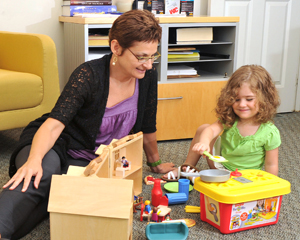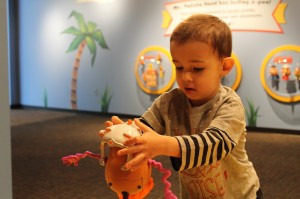Top Toys for Speech Therapy
While speech therapy is definitely going digital, you can still reap the benefits of using timeless toys like dolls and games to elicit communication and encourage proper sentence structure. Many speech-language pathologists (SLPs) customize their use of toys to the child’s individual interests. For example, an SLP might use a Grover doll for a child who loves “Sesame Street” or a Disney character for a child who loves “Aladdin.” Keeping the child engaged in learning is crucial to encourage progress.
Toy Selection
Talk to your child’s SLP about the toys that she uses in speech therapy and ask for recommendations. The Mommy Speech Therapy blog advises parents to select toys that have a face in order to encourage communication and social interaction. For example, instead of selecting toy blocks, select small toy people that can interact with toy picnic food.
Select toys that can be used in a variety of settings to stimulate the child’s imagination. Your child could have a princess doll run off to marry a G.I. Joe, for example. Select toys that can be used to build your child’s vocabulary. Use toys that mimic real objects – like play kitchens and classrooms.
Tips for Best Results
When you play with your child, do so in an area free of other distractions. Clear away any other toys from the floor and turn off the TV or radio. Bring out just one toy or set of toys at a time so that your child can give it his full attention. While playing, talk frequently and repeat target words to help reinforce the lesson. However, remember to give your child time to respond. When you notice that your child begins to lose interest, stop the play session. Over time, his attention span should lengthen.
Mr. Potato Head
Mr. Potato Head is a classic toy that is particularly helpful for children who have trouble following directions, such as children with receptive language disorders. For example, put one of Mr. Potato Head’s ears in its proper place. Hand your child the other ear and ask him to do the same.
Children with expressive language disorders can use Mr. Potato Head to learn connector words. For example, point to the nose and then point to where the nose should go on the face. Say, “This is the nose. Where does the nose go? The nose goes ON the face!” Then, describe Mr. Potato Head’s parts and ask your child to do the same.
Toy Phones
Toy phones are practically a must-have in any speech therapy toy chest. In a pinch, you can always connect a couple of tin cans together with a piece of string for pretend phones. Toy phones are useful for eliciting speech from reluctant talkers, stutterers, and children who have trouble with articulation and fluency. Make pretend phone calls with your child and use funny voices. While on the “phone,” ask your child simple questions to elicit speech. Avoid open-ended questions. Instead of asking, “What would you like to do today?” ask “Would you like to go to the park today?”
Board Games
Choose any board games that you think will capture your child’s interest. Guess Who? and Guess Where? are games that require questions and answers, which is ideal for encouraging communication. If your child prefers Candyland or other classic board games, you can turn them into speech therapy tools. Make up new rules that require your child to say one word from his current vocab list every time he rolls the dice. For games in which you win by collecting cards or similar objects, have your child use one new target word for each card that he receives.
Dolls
Use your child’s favorite doll to teach new words and proper sentence structure. Even if you have a boy who doesn’t play with dolls, you can use his teddy bear or any other favorite stuffed animal. Dolls are useful for teaching the correct articulation of individual sounds – such as the “b” in “baby” and “bottle.” You can also use them to introduce new words. It may be difficult to teach the concept of “cold” with a flashcard, but you can use a doll to demonstrate it. Ask your child, “Is Susie cold? I’m cold!” while you grip your arms together and shiver to demonstrate.
Encourage your child to use his new words together in a sentence. If he says, “Bear Bear cold!” you can respond by saying, “Yes, Bear Bear is cold. It is a cold day today. If we go inside, we won’t be as cold. Would you like to go inside to get warm?” Responding in this manner models effective speech patterns and shows your child how to use his new vocabulary words.





